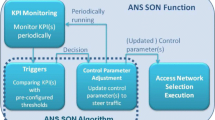Abstract
The commercial success of cellular networks, combined with advances in digital electronics, signal processing, and telecommunications research have lead to the design of next generation 4G-based long term evolution (LTE) wireless systems. The key essence of these emerging, LTE cellular systems lie in deployment of multiple femtocells for improved coverage and higher data rates. However, the arbitrary deployment of a wide number of femtocells makes the configuration, management and planning of LTE systems quite complex and challenging. In order to support dynamic and efficient network configuration, every cell needs to be assigned a particular Physical Cell ID (PCID). In this paper we show that the dynamic, optimal PCID allocation problem in LTE systems is NP-complete. Subsequently we provide a near-optimal solution using Self-Organizing Networks which models the problem using new merge operations and explores the search space using a suitable randomized algorithmic approach. We also discuss two feasible options for dynamic auto-configuration of the system and analyze the algorithm to prove its convergence. Simulation results point out that our proposed near-optimal solution dynamically achieves ∼85−90 % of global optimal auto-configuration in computationally feasible time.








Similar content being viewed by others
References
3GPP TS 36.300. (2008). EUTRAN Overall Description. Rel.8.
3GPP TS 36.902. (2008). Self-configuration and self-optimizing network use cases and solutions. Rel.8.
Propagation data and prediction methods for the planning of indoor radio communication systems and the radio local area networks in the frequency range 900 MHz to 100 GHz, ITU-R Recommendations, Geneva (2001).
Amirijoo, M., Frenger, P., Gunnarsson, F., Kallin, H., Moe, J., & Zetterberg, K. (2008). Neighbor cell relation list and physical cell identity self-organization in lte. In Proceedings of IEEE international conference on communications (ICC08), pp. 37–41.
Bai, Y., Zhou, J., & Chen, L. (2009). Hybrid spectrum usage for overlaying LTE macrocell and femtocell. In IEEE global telecommunications conference (GlobeCom) 2009.
Bandh, T., Carle, G., & Sanneck, H. (2009). Graph coloring based physical-cell-id assignment for lte networks. In Proceedings of ACM international conference on wireless communications and mobile computing (IWCMC09), pp. 116–120.
Box, F. (1978). A heuristic technique for assigning frequencies to mobile radio nets. IEEE Transactions on Vehicular Technology, 27, 57–64.
Chu, R.-C., Wan, J.-Z. & Yee, M.-F. (1997). Pn offset planning strategies for non-uniform cdma networks. In Proceedings of IEEE vehicular technology conference (VTC97), pp. 1543–1547.
Eiben, A. E., & Smith, J. E. (2007). Introduction to evolutionary computing. Springer, Natural Computing Series.
Even, S. (1973). Algorithmic combinatorics. London: Collier-Macmillan.
Garey, M. R. (1979). Computers and intractability: A guide to the theory of NP-completeness. San Francisco: W. H. Freeman Publishers.
Iosifescu, M. (1980). Finite Markov processes and their applications. Wiley: Chichester.
Joyce, R.-M., Griparis, T., Conroy, G.-R., Graves, B.-D., & OsbornKo, I.-J. (2003). A novel code planning approach for a wcdma network. In Proceedings of 3G mobile communication technologies, pp. 31–36.
Jung, Y.-H., & Lee, Y.-H. (2001). Scrambling code planning for 3gpp w-cdma systems. In Proceedings of IEEE vehicular technology conference (VTC01-Spring), pp. 2431–2434.
Kourtis, S. (2000). Code planning strategy for umts-fdd networks. In Proceedings of IEEE vehicular technology conference (VTC00-Spring), (Tokyo), pp. 815–819.
Rosenthal, J. S. (1995). Minorization conditions and convergence rates for Markov chain Monte Carlo. Journal of the American Statistical Association, 90(430), 558–566.
Rouskas, A.-N., Kazantzakis, M.-G., & Anagnostou, M.-E. (1999). Minimization of frequency assignment span in cellular networks. IEEE Transactions on Vehicular Technology, 48, 873–882.
Socrates—FP7, http://www.fp7-socrates.org, December, 2008.
Smith, C., & Collins, D. (2001). 3G wireless networks (5th edn.). New York: McGraw-Hill Professional.
Thavarajah, A., & Lam, W.-H. (1999). Heuristic approach for optimal channel assignment in cellular mobile systems. IEE Proceedings on Communications, 146, 196–200.
West, D. B. (2001). Introduction to graph theory. Upper Saddle River: Prentice Hall Publications.
Acknowledgments
The work of Prof. Navrati Saxena is supported by National Research Foundation (NRF) of Korea, under the project number 2013R1A1A2009392 and Faculty Research Fund, Sungkyunkwan University, 2012, S-2012-1393-000. The authors would also like to express sincere thanks to the editor Prof. Jun Zheng and the anonymous reviewers for providing valuable comments to improve the quality of the work.
Author information
Authors and Affiliations
Corresponding author
Rights and permissions
About this article
Cite this article
Saxena, N., Roy, A., Kim, H. et al. Auto-configuration of Physical Cell ID in LTE femtocellular systems using Self Organizing Networks. Wireless Netw 20, 1107–1120 (2014). https://doi.org/10.1007/s11276-013-0636-3
Published:
Issue Date:
DOI: https://doi.org/10.1007/s11276-013-0636-3



